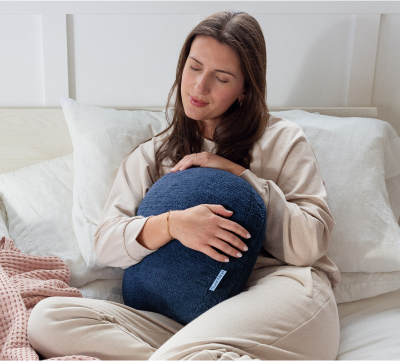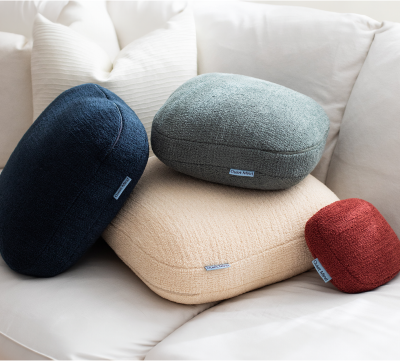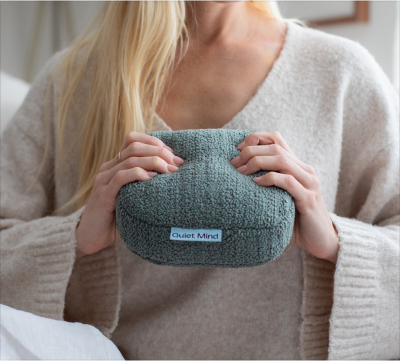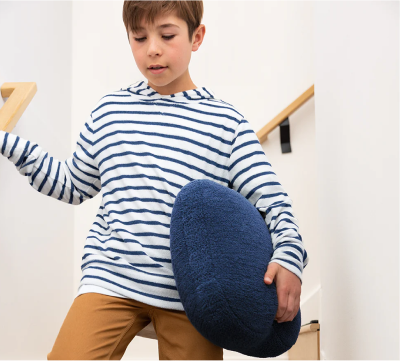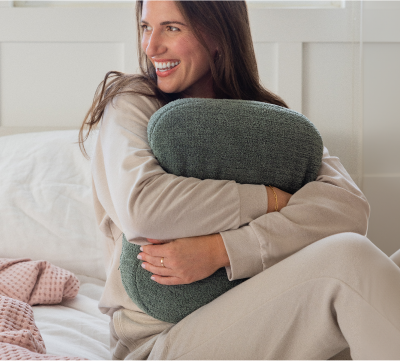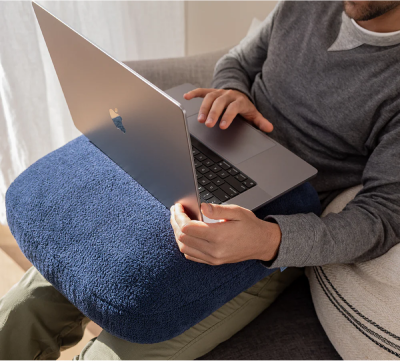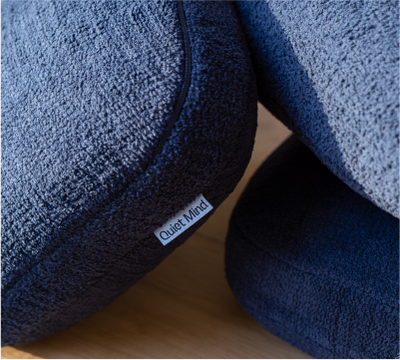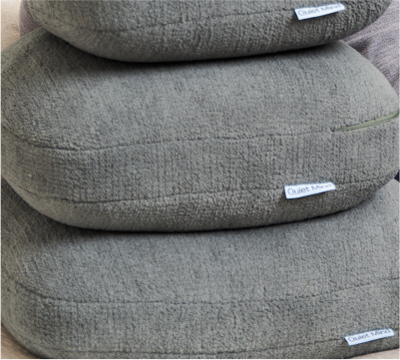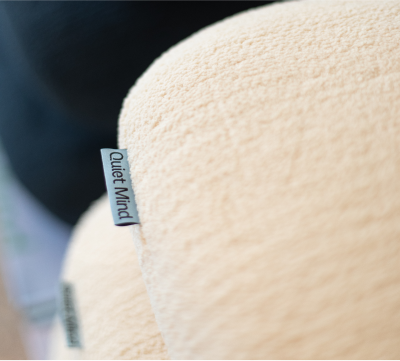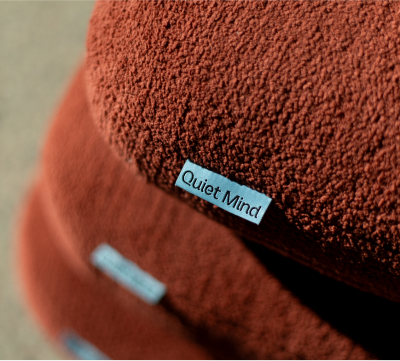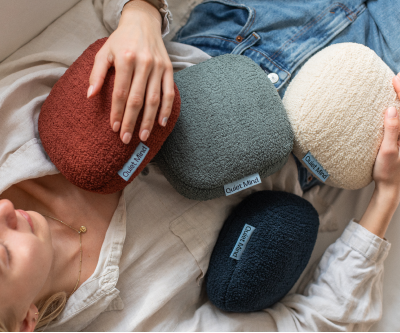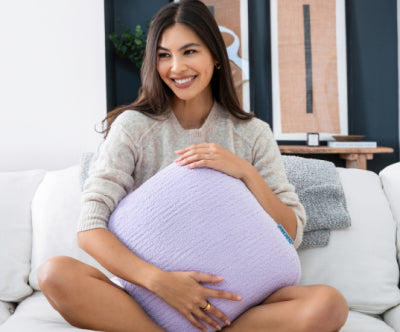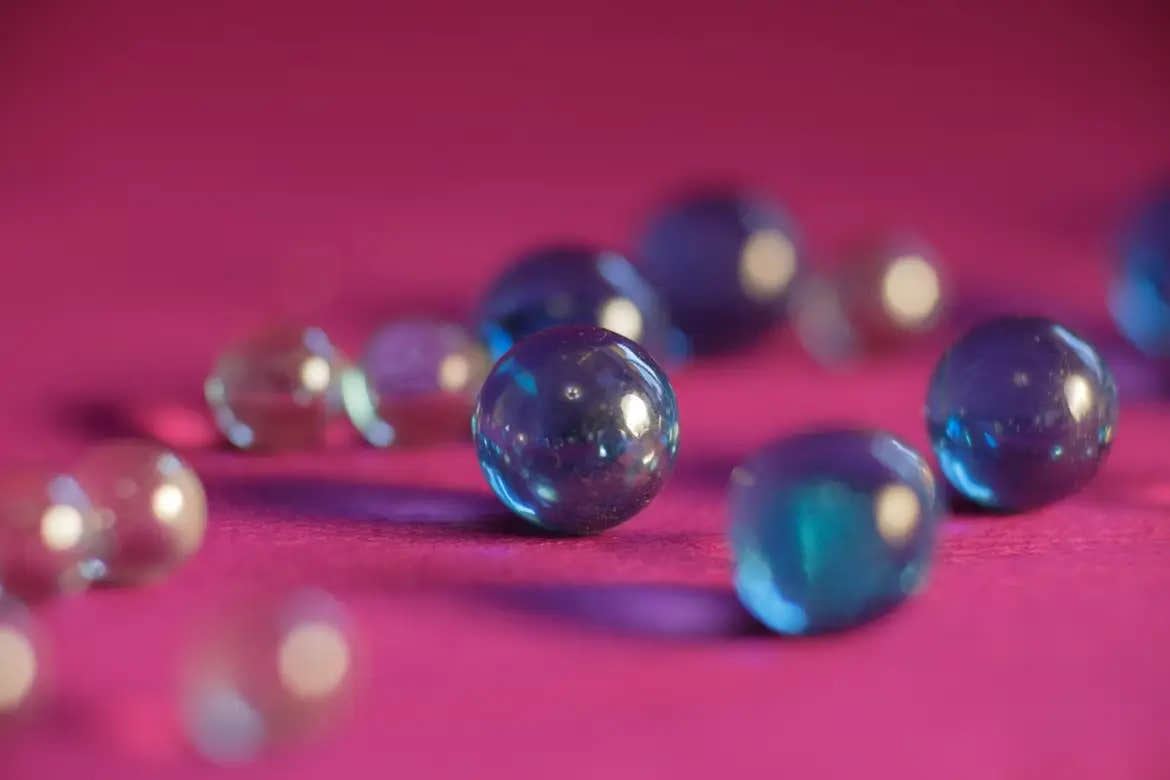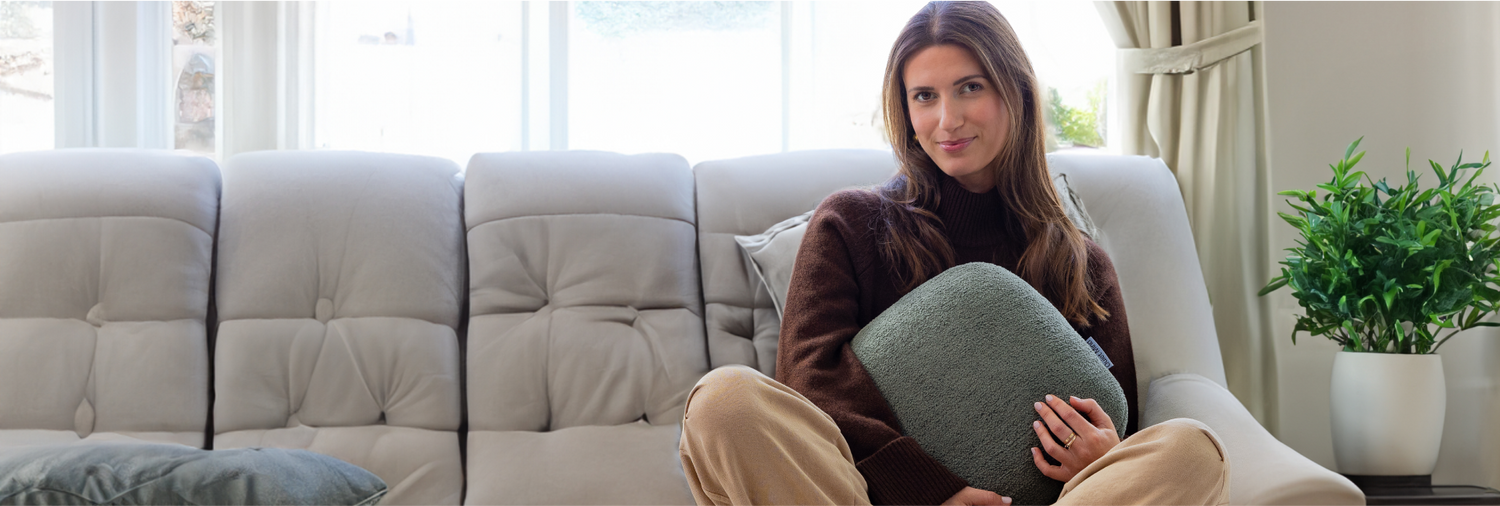Calm doesn't always begin in the mind. Sometimes, it starts with something physical, something as simple as applying gentle weight to the body. Weighted pillows offer this kind of support, grounding the nervous system and inviting a sense of relaxation. But what creates that sense of calm isn’t just the pillow, it’s what’s inside it.
The materials used to fill a weighted pillow shape everything from how it feels on your chest to how it helps you fall asleep. In this guide, we explore common weighted pillow filling types, their sensory properties, and how to select the right one for your needs.
What Is a Weighted Pillow and How Does It Work?
A weighted pillow is more than a cozy accessory. Like a small weighted blanket, it's designed to support the nervous system using deep pressure stimulation (DPS), a technique that calms the body by applying gentle, even weight to specific areas like the chest, lap, or neck.
This deep pressure triggers a parasympathetic response, helping slow the heart rate, deepen the breath, and release feel-good neurotransmitters like serotonin and dopamine. This natural shift can help individuals with anxiety, ADHD, or sleep disorders settle more easily into a state of rest.
If you're wondering whether weighted pillows are good for you, their calming effect on the nervous system makes them a versatile tool for both sleep and sensory regulation.
Benefits of a weighted pillow may include:
- Reduced restlessness and overstimulation.
- Enhanced relaxation and emotional regulation.
- Better focus and attention, especially during transitions.
- More restful sleep, particularly when paired with calming routines.
Whether you’re easing into meditation or trying to fall asleep after a long day, the right pillow becomes more than support, it becomes part of your daily rhythm of care.
Common Fillings Used in Weighted Pillows
The filling isn’t just about how much the pillow weighs. It affects texture, temperature, sound, and how evenly the pressure is distributed. Each material offers a unique sensory profile.
Glass Beads: Smooth, Silent, and Subtle
- Evenly distributed for balanced, consistent pressure.
- Virtually silent during use, ideal for sensory-sensitive individuals.
- Hypoallergenic and non-toxic.
- Often used in high-quality weighted blankets and pillows.
Glass beads are a popular choice for those seeking minimal sound and maximum calm. Their fine, sand-like texture allows for fluid movement and even weight across the pillow’s surface.
Poly (Plastic) Pellets: Durable and Accessible
- Made from BPA-free plastic pellets.
- Slightly larger and more textured than glass beads.
- Affordable and easy to source.
- May produce gentle sound or shifting during use.
Though less refined than glass, plastic pellets offer reliable weight. They’re often used when people make a weighted pillow at home due to their availability and lower cost.
Natural Fillers: Organic, Textured, and Earthy
Natural options include:
- Buckwheat hulls: Moldable, breathable, and long-lasting.
- Flaxseed or millet: Retains warmth and conforms to the body.
- Rice or corn: Organic and comforting, but less durable.
Natural fillers offer warmth and grounding but may rustle slightly or retain heat. They're often chosen by those prioritizing eco-friendly options and an earthy sensory experience.
Glass Beads vs Poly Pellets vs Natural Fillers: Key Differences
Each type of filling creates a different sensory experience and level of maintenance. This comparison helps highlight what to expect based on your needs.
|
Feature |
Glass Beads |
Plastic Pellets |
Natural Fillers |
|
Smoothness |
High - feels fluid and soft |
Medium - slightly textured feel |
Low - earthy and coarse |
|
Noise Level |
Low - virtually silent |
Medium - gentle shifting sounds |
High - rustling, especially with movement |
|
Hypoallergenic |
Yes |
Often yes (if BPA-free) |
Varies - depends on source and treatment |
|
Weight Distribution |
Even and consistent across surface |
Slightly uneven but stable |
Can shift or settle in areas |
|
Temperature Retention |
Low to moderate - stays cool |
Low — does not hold heat |
High - retains warmth, especially flax or rice |
|
Care Needs |
Often machine washable |
Machine washable (check seam strength) |
Spot clean only - moisture-sensitive |
|
Best For |
Sleep, anxiety relief, sensory regulation |
Travel, durable daily use |
Meditation, grounding, eco-conscious users |
How Filling Materials Affect the Feel and Function of Your Weighted Pillow
The way a pillow feels and functions depends on more than its outer fabric. The internal material influences everything from how well you sleep to how your body processes sensory input.
Weight Distribution and Pressure Points
- Glass beads: Provide smooth, even pressure that enhances deep pressure therapy
- Plastic pellets: Slightly bulkier, with a modest shift in weight across the surface
- Natural fillers: Tend to shift more, creating a soft, nest-like feel
If you want your pillow to mimic the even distribution of a weighted blanket, glass beads may be your best fit.
Texture, Temperature, and Sound
- Glass beads are nearly silent and produce little friction against fabric like cotton or linen.
- Buckwheat hulls and flaxseed offer a more natural texture but may produce rustling sounds as you move.
- Plastic pellets are durable but may make a light shifting sound, something to consider if you’re easily distracted.
Pairing any fill type with a soft, breathable cover like bamboo, linen, or organic cotton enhances the tactile experience and supports airflow, which is especially helpful for those prone to overheating.
What Is the Best Filling for Weighted Pillows?
There’s no single best filling, only what feels right for your body and nervous system. The best choice depends on your sensory preferences, comfort needs, and how you plan to use the pillow.
Choosing Based on Comfort, Use Case, and Sensory Needs
Each filling responds differently to touch, movement, and heat. Whether you’re trying to fall asleep, calm your mind, or ease tension in the chest, matching your sensory preferences is key.
|
Use Case |
Recommended Filling |
Why It Works |
|
Sleep |
Glass beads or flaxseed |
Quiet, smooth, or naturally warming options |
|
Anxiety Relief |
Glass beads |
Even pressure and minimal sensory noise |
|
Travel |
Poly pellets |
Lightweight, durable, easy to clean |
|
Meditation |
Natural grains |
Soothing texture, retains warmth if gently heated |
People with ADHD or sensory sensitivities may benefit from the consistent, silent texture of glass beads, while those drawn to earthy, grounding materials often prefer buckwheat hulls or flaxseed. The key is selecting the right texture, weight, and size to meet your unique needs.
Are Weighted Pillow Fillings Safe and Non-Toxic?
Safety is a foundation, especially when a product is meant to rest on your chest, lap, or near the face. The benefits of a weighted pillow can only be fully enjoyed when the materials are clean, stable, and body-safe.
Hypoallergenic Materials and Quality Standards
Look for:
- Non-toxic, lead-free glass beads.
- BPA-free plastic pellets.
- Certified organic grains (if choosing natural fillers).
Additional safety features include:
- Breathable fabrics like cotton or linen to prevent moisture build-up.
- Sealed seams to avoid leaks.
- No added fragrances or dyes, which can cause irritation.
Fill Types to Avoid for Sensitive Users
- Scented grains or herbal additives, which may trigger allergies.
- Unsealed or untreated natural fillers prone to humidity or pests.
- Low-quality synthetic fillers, which may degrade or emit chemical odors.
Choosing well-vetted materials ensures that your pillow is more than just effective, it’s trustworthy.
How to Choose the Right Weight Pillow Filling Material for Your Needs?
Choosing a weighted pillow isn’t just about comfort. It’s about how the filling material interacts with your body, senses, and daily rhythms. The type of fill inside affects everything from how the pillow feels on your chest to how well it helps you stay regulated, relaxed, or focused.
One of the first things people wonder is how heavy a weighted pillow should be. While a general guideline is to use a weight that falls between 5 to 10 percent of your body weight, personal sensitivity matters just as much. A lighter fill may be better for daytime use or travel, while a slightly heavier option can offer deeper grounding during sleep or stress relief.
Key Considerations When Choosing Fill Type
Consider the following factors when choosing your weighted pillow’s fill type:
-
Weight: Glass beads and plastic pellets provide stable weight without bulk. Natural grains may feel heavier for their size and can hold warmth longer. Choose a weight that feels grounding without being restrictive.
-
Texture: Glass beads feel smooth and fluid under fabric. Plastic pellets have a firmer, slightly textured feel. Natural fillers like flaxseed or buckwheat hulls offer a more earthy, nest-like sensation that conforms to the body.
-
Sound: If you're sensitive to sound during movement or rest, glass beads are nearly silent. Plastic pellets may create a gentle shift sound, while natural fillers can rustle more noticeably.
-
Temperature and Breathability: Natural fillers can retain heat, which may feel cozy or too warm depending on your preferences. Pairing any fill with breathable fabric like cotton or bamboo helps support airflow and comfort.
- Durability and Care: Glass and plastic fillers are generally more durable and easier to clean. Natural fillers may degrade over time or require extra care to avoid moisture buildup.
A Quiet Mind weighted pillow, for example, uses hypoallergenic glass beads that stay evenly distributed and silent, wrapped in a soft, breathable cover to support both sensory comfort and easy care.
Choosing the right fill type means listening to your body’s needs and selecting a material that helps you feel calm, safe, and supported no matter how or when you use it.
Best Uses: Sleep, Stress Relief, Travel, and More
Different moments call for different features, these common use cases show how to match your pillow to your needs.
|
Use Case |
Suggested Features |
|
Sleep |
Breathable fabric, silent fill, gentle weight |
|
Stress Relief |
Even weight, soft texture, lap-sized |
|
Travel |
Compact size, durable fill, easy-clean cover |
|
Meditation |
Natural texture, grounding weight |
No matter your choice of filling, your comfort will also depend on the use of a weighted pillow, whether for sleep, meditation, or emotional grounding.
How to Care for a Weighted Pillow: Does Fill Type Matter?
Caring for your weighted pillow properly helps preserve its texture, shape, and safety, especially since it often rests close to the body. While all weighted pillows benefit from gentle handling, the type of fill inside can affect how often and how easily you can clean it.
Some materials are naturally more moisture-resistant, while others require extra care to prevent mold, clumping, or fabric wear. Understanding these differences ensures your pillow remains both comforting and hygienic over time.
Machine-Washable vs Spot-Clean Only
The care instructions for your pillow depend heavily on both the outer fabric and the type of fill it contains.
Machine-Washable Pillows:
- Often filled with glass beads or plastic pellets, which can withstand gentle machine cycles.
- Look for removable, washable covers made of cotton, bamboo, or linen.
- Always check for sealed seams to prevent beads or pellets from escaping in the wash.
Spot-Clean Only Pillows:
- Typically filled with natural grains like flaxseed, rice, or buckwheat hulls. These materials may absorb moisture and are prone to mold or clumping when wet.
- Use a damp cloth for surface cleaning and allow the pillow to air-dry fully.
- Keep these pillows in a dry, well-ventilated area between uses to maintain freshness and avoid humidity damage.
No matter the fill, always refer to the manufacturer’s instructions before cleaning. Using the wrong method can reduce the effectiveness of the weight or compromise the pillow’s structure.
Durability of Common Fillers Over Time
Each fill type not only feels different but also ages differently. Understanding the natural lifespan of your weighted pillow helps you decide when to refresh it or replace the filling.
|
Filling Type |
Durability |
Care Notes |
|
Glass Beads |
Long-lasting |
Resistant to breakdown, minimal noise, machine washable in many cases |
|
Plastic Pellets |
Durable but slightly bulky |
Holds shape well, may create light sound with movement |
|
Natural Fillers |
Moderate to low |
May degrade with moisture exposure or over time, spot clean only |
Natural fillers often provide a warm, earthy experience but may need more frequent replacement, especially with daily use. In contrast, glass and plastic bead fillings offer longer life and lower maintenance, making them ideal for everyday grounding tools.
To extend your pillow’s lifespan, store it in a breathable, dry space and avoid heavy moisture exposure. Using a protective cover can also reduce wear on the outer fabric and make regular care easier.
Final Thoughts: Understanding What’s Inside Your Weighted Pillow
The filling inside a weighted pillow shapes far more than its weight, it defines its comfort, sensory impact, and overall effectiveness. From smooth, silent glass beads to organic grains like flaxseed or buckwheat hulls, each material offers a distinct experience of touch, sound, and support.
Choosing the right weighted pillow means considering how you want to feel. Do you need silent stillness to fall asleep? A warming, organic texture for relaxation? Or a durable, travel-friendly companion to ease daily stress? The best pillow will reflect your sensory needs, body cues, and lifestyle preferences.
Above all, a well-chosen weighted pillow offers more than physical comfort. It can help calm the nervous system, ease restlessness, and encourage restful sleep one small, grounded step toward balance and ease.
About Quiet Mind
At Quiet Mind, we design weighted pillows with care because what’s inside matters. Our focus is on more than comfort. It’s about creating a safe, grounding experience that supports relaxation, sensory regulation, and restful sleep.
Each Quiet Mind weighted pillow is filled with hypoallergenic glass beads and wrapped in soft, breathable fabrics like cotton and linen. We avoid unnecessary additives, fragrances, or fillers that may disrupt your sensory experience. Every detail is chosen to apply gentle pressure where it's needed most, helping ease restlessness, support the nervous system, and encourage calm moments throughout your day.
Whether you're managing stress, navigating ADHD, or simply looking for a quieter way to wind down, our pillows are built to help you feel safe, settled, and supported naturally.
FAQ
What is deep pressure stimulation, and how does it relate to weighted pillows?
Deep pressure stimulation is gentle, consistent pressure applied to the body. Weighted pillows use this principle to promote calm, improve sleep, and reduce stress.
What are the most common fillings used in weighted pillows?
Glass beads, poly pellets, and natural fillers like rice or flaxseed. Each varies in texture, sound, and weight distribution.
How do I choose the right weighted pillow for my needs?
Consider your body size, sensory preferences, intended use, and whether you prefer natural or synthetic materials.
Are weighted pillow fillings safe and non-toxic?
Yes, when made with high-quality, hypoallergenic materials like lead-free glass beads or BPA-free poly pellets. Always check product certifications.
Can weighted pillows help with anxiety and stress relief?
Yes. The pressure stimulates the parasympathetic nervous system, helping regulate breath, reduce cortisol, and calm the mind.
